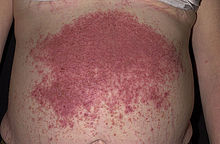
Back التهاب الجلد الهربسي الشكل Arabic Dermatitis herpetiforme Catalan Duhringova nemoc Czech Dermatitis herpetiformis Duhring German Dermatitis herpetiforme Spanish Ihokeliakia Finnish Dermatite herpétiforme French Dermatite erpetiforme di Duhring Italian Dermatitis herpetiformis Dutch Dermatitis herpetiformis NB
| Dermatitis herpetiformis | |
|---|---|
| Other names | Duhring's disease[1][2] |
 | |
| Characteristic rash of dermatitis herpetiformis | |
| Specialty | Dermatology |
Dermatitis herpetiformis (DH) is a chronic autoimmune blistering skin condition,[3] characterised by intensely itchy blisters filled with a watery fluid.[4] DH is a cutaneous manifestation of coeliac disease,[5] although the exact causal mechanism is not known. DH is neither related to nor caused by herpes virus; the name means that it is a skin inflammation having an appearance (Latin: -formis) similar to herpes.
The age of onset is usually about 15 to 40, but DH also may affect children and the elderly. Men are slightly more affected than women.[6] Estimates of DH prevalence vary from 1 in 400 to 1 in 10,000. It is most common in patients of northern European and northern Indian ancestry, and is associated with the human leukocyte antigen (HLA) haplotype HLA-DQ2 or HLA-DQ8 along with coeliac disease and gluten sensitivity.[7][8][9][10][11]
Dermatitis herpetiformis was first described by Louis Adolphus Duhring in 1884.[12] A connection between DH and coeliac disease was recognized in 1967.[12][13]
- ^ Freedberg, et al. (2003). Fitzpatrick's Dermatology in General Medicine. (6th ed.). McGraw-Hill. ISBN 0-07-138076-0.
- ^ Rapini, Ronald P.; Bolognia, Jean L.; Jorizzo, Joseph L. (2007). Dermatology: 2-Volume Set. St. Louis: Mosby. ISBN 978-1-4160-2999-1.
- ^ Singal A, Bhattacharya SN, Baruah MC (2002). "Dermatitis herpetiformis and rheumatoid arthritis". Indian J Dermatol Venereol Leprol. 68 (4): 229–30. PMID 17656946.
- ^ Cite error: The named reference
AOCDwas invoked but never defined (see the help page). - ^ "Dermatitis Herpetiformis". Retrieved 2015-04-20.[permanent dead link]
- ^ Salmi, T. T.; Hervonen, K.; Kautiainen, H.; Collin, P.; Reunala, T. (August 2011). "Prevalence and incidence of dermatitis herpetiformis: a 40-year prospective study from Finland". The British Journal of Dermatology. 165 (2): 354–359. doi:10.1111/j.1365-2133.2011.10385.x. ISSN 1365-2133. PMID 21517799. S2CID 23165241.
- ^ Miller JL, Collins K, Sams HH, Boyd A (2007-05-18). "Dermatitis Herpetiformis". emedicine from WebMD.
{{cite journal}}: Cite journal requires|journal=(help) - ^ Cite error: The named reference
pmid18319038was invoked but never defined (see the help page). - ^ "Dermatitis Herpetiformis". Patient UK. Archived from the original on 2013-07-06. Retrieved 2009-07-22.
- ^ "Dermatitis Herpetiformis". National Digestive Diseases Information Clearinghouse. Archived from the original on 2009-07-20. Retrieved 2009-07-22.
- ^ Spurkland, A.; Ingvarsson, G.; Falk, E. S.; Knutsen, I.; Sollid, L. M.; Thorsby, E. (January 1997). "Dermatitis herpetiformis and celiac disease are both primarily associated with the HLA-DQ (alpha 1*0501, beta 1*02) or the HLA-DQ (alpha 1*03, beta 1*0302) heterodimers". Tissue Antigens. 49 (1): 29–34. doi:10.1111/j.1399-0039.1997.tb02706.x. ISSN 0001-2815. PMID 9027962.
- ^ a b "What Is Dermatitis Herpetiformis?".
- ^ Marietta EV, Camilleri MJ, Castro LA, Krause PK, Pittelkow MR, Murray JA (February 2008). "Transglutaminase autoantibodies in dermatitis herpetiformis and celiac sprue". J. Invest. Dermatol. 128 (2): 332–5. doi:10.1038/sj.jid.5701041. PMID 17762854.